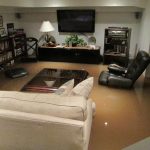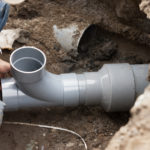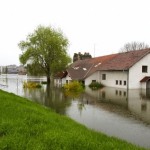1. What causes water damage?
Unlike wind damage, water damage comes from a wide variety of sources. Heavy rain in a short amount of time, a broken pipe, a backed-up sewage line, and a leaking appliance are all common sources of water damage. No matter how excess water gets into your home or business, the most important thing to remember is that it must be removed as soon as possible.
2. Why can’t I let the water evaporate on its own?

Excess water doesn’t evaporate; more likely it’s absorbed by porous materials like furniture, textiles, drywall, and insulation. This helps spread the water, and the damage, further through the building. As more items become damp, they’re at risk for developing mold and experiencing further damage.
Mold spores are everywhere in the air, even if you use air purifiers, and feed from common household materials like paper, clothing, and drywall. All they need is moisture to grow, which is why mold growth begins in as fast as 48 hours after a water leak.
3. How does a restoration company clean up excess water?
The restoration technicians remove all items that have been damaged by water, mold, or other contaminants. This usually includes furniture, drywall, insulation, plywood, and carpeting. It’s important to remove these items so excess water won’t be trapped inside or behind them. After items are removed, all standing water is removed, and dehumidifiers and heavy-duty fans are used to completely dry the area. Once the area is dry, it’s completely cleaned and sanitized.
While the property is drying, the technicians will check for mold growth and other microbes. If they find any, the infestation will be completely removed, and the area treated with disinfectants if needed.
4. What should I look for in a restoration company?
Look for a company that uses technicians who are certified by the Institute of Inspection, Cleaning, and Restoration Certification (IICRC). This means they have gone through extensive training in restoration, structural drying, and microbial remediation. They will be able to clean and restore a wide variety of items safely and effectively.
5. Will I have to move out during the restoration?

That depends on the extent of the damage, health conditions of residents, and personal preferences. Your insurance company may have their own policies, so check with them. It’s important to keep in mind that children and pets must be kept away from drying and restoration equipment for their own safety.
The equipment will make noise and there will be drafts, so people with young children or who work at home may want to consider making other accommodations for the duration of the drying process. People with asthma and allergies may not want to be in the area when mold spores and allergens are being blown through the air.
6. How long will it take for my home to dry?
Drying times depend on several factors, including the source of the excess water, the amount of time items were wet, weather conditions, and how much of the building has been affected by water. It’s impossible to determine dryness by looking or even touching; a carpet may feel dry, but the padding or flooring underneath can still be wet. A rough estimate of three to five days for drying works well in most situations.
7. My house smells awful – will that go away?
Fortunately, yes. Increased humidity can lead to odors from drying building materials or other items. As the area dries out, the odors should decrease. If not, remediation experts can use deodorizers to eliminate lingering smells.
8. How much will all this equipment affect my utility bill?
Drying and dehumidification equipment costs roughly $1 per day to run, based on average utility rates.
No matter how excess water gets into your property in West Fargo, ND, you need it removed quickly before it causes irreparable damage. Restoration professionals provides high quality water damage restoration services to remove excess water from homes and businesses and repair the damage it causes to structures and their contents. We use the most effective equipment available to the industry, so we can provide our clients with the highest quality services.
Water damage restoration costs vary, depending on the extent of the damage and the presence of mold. According to HomeAdvisor.com, the national average to remove standing water is $2,808. The national average to repair water damage is $2,587. The national average to test for mold is $687 and the average cost to remove it is $2,236.




